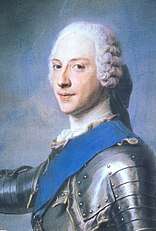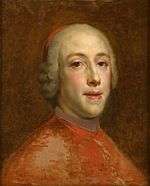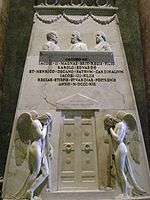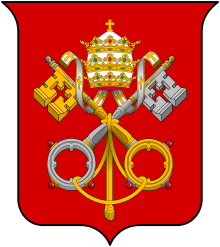Henry Benedict Stuart
Henry Benedict Thomas Edward Maria Clement Francis Xavier Stuart, Cardinal Duke of York (6 March 1725 – 13 July 1807) was a Roman Catholic cardinal, as well as the fourth and final Jacobite heir to claim the thrones of England, Scotland, France, and Ireland publicly. Unlike his father, James Francis Edward Stuart, and brother, Charles Edward Stuart, Henry made no effort to seize the throne. After Charles's death in January 1788 the Papacy did not recognise Henry as the lawful ruler of England, Scotland, and Ireland, but referred to him as the Cardinal Duke of York.[2]
Henry Benedict Stuart | |
|---|---|
| Cardinal-Bishop of Ostia and Velletri and Dean of the College of Cardinals | |
_-002.jpg) Henry Benedict Stuart, "Cardinal Duke of York" | |
| Province | Rome |
| Diocese | Ostia and Velletri |
| Appointed | 26 September 1803 |
| Term ended | 13 July 1807 |
| Predecessor | Gian Francesco Albani |
| Successor | Leonardo Antonelli |
| Other posts |
|
| Orders | |
| Ordination | 1 September 1748 by Pope Benedict XIV |
| Consecration | 19 November 1758 by Pope Clement XIII |
| Created cardinal | 3 July 1747 |
| Personal details | |
| Birth name | Henry Benedict Mary Clement Thomas Francis Xavier Stuart |
| Born | 6 March 1725[1] Palazzo Muti, Rome, Papal States |
| Died | 13 July 1807 (aged 82) Frascati, Rome, Papal States |
| Buried | St. Peter's Basilica, Vatican City |
| Parents | |
| Previous post |
|
| Coat of arms | |
He spent his life in the Papal States and had a long career in the clergy of the Roman Catholic Church, rising to become the Dean of the College of Cardinals and Cardinal-Bishop of Ostia and Velletri. At the time of his death he was (and still is) one of the longest-serving cardinals in the Church's history.
In his youth, Henry's father made him Duke of York (in the Jacobite Peerage), and it was by this title that he was best known. Upon the death of his brother in 1788, Henry became known by Jacobites, and within his personal entourage, as Henry IX of England and Ireland, and Henry I of Scotland, although publicly he referred to himself as Cardinal-Duke of York nuncupatus.
Early life

Henry was born in exile at the Palazzo Muti in Rome on 6 March 1725 and baptised on the same day by Pope Benedict XIII,[3] 37 years after his grandfather James II and VII lost the throne, and ten years after his father's failed attempt to regain it. His father was James Francis Edward Stuart, known to his opponents as "the Old Pretender". His mother was the Princess Maria Klementyna Sobieska, granddaughter of the Polish King and Lithuanian Grand-Duke, John III Sobieski. Henry was apparently an intelligent child who could spell and write better than his older brother Charles. More introverted than Charles and more cautious in his approach to problems, Henry is described as pious and mild-mannered.[4]
Henry went to France in 1745 to help his brother, Prince Charles Edward Stuart ("Bonnie Prince Charlie", or "the Young Pretender") prepare the Jacobite rising of 1745. Attached to the French army, he was in nominal command of a cross-channel invasion force of some 10,000 men that never made it out of Dunkirk, and subsequently served under Maurice de Saxe at the siege of Antwerp. After the defeat at Culloden, Henry Stuart returned to Italy.
Ecclesiastical career
On 30 June 1747 Pope Benedict XIV conferred him with tonsure and created him Cardinal-Deacon of Santa Maria in Campitelli in a special consistory held on 3 July 1747. On 27 August 1747 he was promoted through the four minor orders by Benedict. He received the subdiaconate on 18 August 1748 and diaconate on 25 August 1748. His elder brother Charles, who was in France at the time, was not in favor of the ecclesiastical honors as he believed they would only serve to further religious prejudice against the Stuarts.[5]
As the cardinalate was a rank rather than one of the priestly orders, Charles hoped that Henry might yet make a politically fortuitous marriage, and was dismayed to discover that his brother had been ordained a priest on 1 September 1748.[3] Later that month, Henry was made Cardinal-Priest, retaining his diaconal church. In 1751, he was made Arch-Priest of the Vatican Basilica.[3]
His revenues from the many ecclesiastical preferments he enjoyed were enormous. His income from abbeys and other pluralities in Flanders, Spain, Naples and France amounted to 40,000 Pounds in British money at the time. He also held sinecure benefices yielding revenues in Spanish America. He owned territory in Mexico, which contributed largely to his income.[6]
Louis XV of France bestowed on the Cardinal the abbeys of Auchin and St. Amand as compensation for having had to evict his brother pursuant to the terms of the Treaty of Aix-la-Chapelle.[5]
In December 1752 his titular seat was changed to Santi Apostoli; and in 1758 the Pope named him Camerlengo of the Sacred College of Cardinals. The responsibilities of this office included administering all property, fees, funds and revenue belonging to the College of Cardinals, celebrating the requiem Mass for a deceased cardinal, and charge of the registry of the Acta Consistoralia. He participated in the conclave of 1758, which elected Pope Clement XIII. In October of that year he was made titular Archbishop of Corinth. The following year, he resigned the title of Santa Maria in Campitelli to assume that of Santa Maria in Trastevere; however, he retained the Church of Santi Apostoli in commendam.
He was made Cardinal-Bishop of Frascati on 13 July 1761.[7] He was appointed Dean of the Sacred College of Cardinals on 26 September 1803, then also succeeding to the See of Ostia and Velletri. He lived and worked in Frascati for many years, descending each afternoon in his carriage to Rome, where his position as vice-chancellor entitled him to the Palazzo della Cancelleria.
Henry was the last claimant to the British throne to touch a person to cure them from the King's Evil.
Henry is described as a beatific, abstemious, wealthy, celibate aesthete who lived to a great age, 'inoffensive and respectable' to the end.[8]
French Revolution and later life

At the time of the French Revolution, he lost his French Royal benefices and sacrificed many other resources to assist Pope Pius VI. This, in addition to the seizure of his Frascati property by the French, caused him to descend into poverty.[9] The British Minister in Venice arranged for Henry to receive an annuity of £4,000 from George III of Great Britain. Although the British government represented this as an act of charity, Henry and the Jacobites considered it to be a first installment on the money which was legally owed to him. (For many years the British government had promised to return the English dowry of his grandmother, Mary of Modena, but never did so.)
The Vatican had recognised James III and VIII as the King of Great Britain and Ireland. After his death in 1766 the Vatican did not recognise Henry's brother Charles, who had converted to Anglicanism in 1750. The Vatican had not, however, overtly recognised the Hanoverian monarchs. However, in November 1792 the Vatican first referred to George III as the King of Great Britain and Ireland instead of the Elector of Hanover. This resulted in a protest by Henry who suggested the insult would result in him not visiting Rome again.[10]
Henry returned to Frascati in 1803. In September of that year he became the Dean of the College of Cardinals and hence Cardinal Bishop of Ostia and Velletri,[9] though he still lived in the episcopal palace at Frascati. He died there on 13 July 1807, aged 82.
Personal relationships

Historians have drawn upon contemporary perceptions to explore the suggestion that Henry was homosexual.[1] These accounts include the writings of Hester Lynch Thrale[11] (1741–1821), and the diplomat and writer Giuseppe Gorani[12] (1740–1819). Gorani admitted to having gathered evidence insufficient to confirm his suspicions either way, but drew attention to the number of handsome clerics that were to be found in Henry's palace. The historian Andrew Lang alluded to James's comment that his younger son would never marry although many marriages had been planned for him.[13]
The writer Gaetano Moroni[14] provides the lengthiest account of Henry's close attachment with his majordomo Monsignor Giovanni Lercari (1722–1802), whom Henry was said to have "loved beyond measure". This closeness led to serious tensions between the cardinal and his father who in 1752 eventually tried to have Lercari dismissed from service and sent from Rome. Henry reacted by attempting to separate his household finances from those of his father, and refused himself to return to Rome from Bologna without Lercari by his side. A public scandal was only narrowly avoided after the personal intervention of Pope Benedict XIV who acted as peace-maker.[15] It was agreed that Lercari would leave the household and with Henry's influence was later made Archbishop of Genoa.
Things became easier after the death of James in 1766. From 1769 onwards Henry remained close to Monsignor Angelo Cesarini, a nobleman from Perugia, who thanks to Henry's protection, won various honours, was made canon of the cathedral in Frascati, and finally in 1801 became Bishop of Milevi. When Henry died, Cesarini was still at his side, as he had been for 32 years. Cesarini was later buried in the church of Santa Maria in Vallicella.
Caution should nevertheless be given against assuming any active sexual relationships, even if they may have had a romantic element, because equally clear in contemporary sources is York's horror of all impropriety.[16]
Legacy
Under his will, which he signed as "Henry R", he was succeeded in all his claimed British rights by his nearest blood-relative and friend, Charles Emmanuel IV of Sardinia. Charles neither asserted nor renounced his Jacobite claims, like his successors. Charles Emmanuel, and the following Kings of Sardinia, had other vital interests in their Italian environment to which championing a hopeless cause in Britain would have been detrimental.
Contrary to popular belief, he did not leave the Crown Jewels to the Prince of Wales, afterwards George IV of the United Kingdom. All his property was entrusted to Monsignor Angelo Cesarini, for distribution. Cesarini sent the Prince of Wales several jewels from Henry's private collection. These included a "Lesser George" (thought to have been worn by Charles I at his execution, and now at Windsor Castle) and a St Andrew's Cross (now at Edinburgh Castle), which are insignia of the orders of the Garter and the Thistle, and also a ruby ring. Even so, the act of sending them to the Hanoverian Prince of Wales should not be construed as renunciation of the Jacobite claim.
Henry Benedict, his brother, his father and his mother are buried in the crypt of St. Peter's Basilica in the Vatican. There is a monument to the Royal Stuarts on one of the columns in the basilica proper, designed by Antonio Canova. The monument was originally commissioned by Monsignor Angelo Cesarini, executor of Henry Benedict's estate. Among the subscribers, curiously, was George IV, who became an admirer of the Stuart legend.
The monument was restored at the expense of the late Queen Elizabeth the Queen Mother.
Titles, styles, honours and arms
Titles as cardinal
During his life, Cardinal Stuart was assigned the following Diaconia and Tituli:
- 13 July 1747 Cardinal Deacon of Santa Maria in Portico
- 16 September 1748 Cardinal Priest of Santa Maria in Portico
- 18 December 1752 Cardinal Priest of Santi XII Apostoli
- 12 February 1759 Cardinal Priest of Santa Maria in Trastevere
- 13 July 1761 Cardinal Bishop of Frascati
- 14 January 1763 Comendatario of San Lorenzo in Damaso (proper of the cardinal vice-chancellor, held in addition to the suburbicarian sees)
- 26 September 1803 Cardinal Bishop of Ostia e Velletri (proper of the dean of the Sacred College of Cardinals)
In March 1774 he became Sub-dean, and on 15 September 1803 – Dean of the Sacred College of Cardinals.
He was a cardinal elector in the papal conclaves of 1758, 1769, 1774–75 and 1799–1800.
Arms
During the pretence of his father and brother, Henry claimed a coat of arms consisting of those of the kingdom, differenced by a crescent argent[17] or white crescent.
Ancestors
| Ancestors of Henry Benedict Stuart | |||||||||||||||||||||||||||||||||||||||||||||||||||||||||||||||||||||||||||||||||||||||||||||||||||||||||||||||||||||||||||||||||||||||||||||||||||||||||||||||||||||||||||||||||||||||||||||||||||||||||||||||||||||||||||||||||||||||||||||||||||||||||||||||||||||||||||||||||||||||||
|---|---|---|---|---|---|---|---|---|---|---|---|---|---|---|---|---|---|---|---|---|---|---|---|---|---|---|---|---|---|---|---|---|---|---|---|---|---|---|---|---|---|---|---|---|---|---|---|---|---|---|---|---|---|---|---|---|---|---|---|---|---|---|---|---|---|---|---|---|---|---|---|---|---|---|---|---|---|---|---|---|---|---|---|---|---|---|---|---|---|---|---|---|---|---|---|---|---|---|---|---|---|---|---|---|---|---|---|---|---|---|---|---|---|---|---|---|---|---|---|---|---|---|---|---|---|---|---|---|---|---|---|---|---|---|---|---|---|---|---|---|---|---|---|---|---|---|---|---|---|---|---|---|---|---|---|---|---|---|---|---|---|---|---|---|---|---|---|---|---|---|---|---|---|---|---|---|---|---|---|---|---|---|---|---|---|---|---|---|---|---|---|---|---|---|---|---|---|---|---|---|---|---|---|---|---|---|---|---|---|---|---|---|---|---|---|---|---|---|---|---|---|---|---|---|---|---|---|---|---|---|---|---|---|---|---|---|---|---|---|---|---|---|---|---|---|---|---|---|---|---|---|---|---|---|---|---|---|---|---|---|---|---|---|---|---|---|---|---|---|---|---|---|---|---|---|---|---|---|---|---|---|
| |||||||||||||||||||||||||||||||||||||||||||||||||||||||||||||||||||||||||||||||||||||||||||||||||||||||||||||||||||||||||||||||||||||||||||||||||||||||||||||||||||||||||||||||||||||||||||||||||||||||||||||||||||||||||||||||||||||||||||||||||||||||||||||||||||||||||||||||||||||||||
See also
- Touch pieces
- Jacobite succession
Notes
- Rosalind K. Marshall, "Henry Benedict (1725–1807)", Oxford Dictionary of National Biography, Oxford University Press, 2004; online edn, May 2010, accessed 24 June 2013.
- MacLeod (1999); 347–348
- Tribe, Shawn. "Vestments of the Cardinal Duke of York: Henry Benedict Stuart".
- "Henry Stuart, cardinal duke of York | British pretender". Encyclopedia Britannica.
- Kelly, Bernard W. (Bernard William) (22 September 1899). "Life of Henry Benedict Stuart, Cardinal Duke of York : with a notice of Rome in his time". London : R. & T. Washbourne – via Internet Archive.
- James Lees-Milne, The Last Stuarts. London: Chatto & Windus, 1983. p. 157
- "Cardinals Created by Benedict XIV (1743-7)". www.gcatholic.org. Retrieved 16 June 2020.
- Haggard, W. D. "Medals of the Pretender (continued)", The Numismatic Chronicle, 3 (1840-41) 149-152, p. 151
- "CATHOLIC ENCYCLOPEDIA: Henry Benedict Maria Clement Stuart". www.newadvent.org.
- The Cardinal King by Brian Fothergill p.205-6
- Piozzi (1951); 874–875
- Gorani (1793); 100–102
- Oxford Dictionary of National Biography, Oxford University Press
- Angeli (1931); 98–108
- F. J. McLynn, Charles Edward Stuart: A Tragedy in Many Acts, London, 1988
- Schofield (2002); 98
- "marks of cadency in the British royal family". www.heraldica.org.
References
- Angeli, Diego (1931) Storia romana di trent'anni, 1770–1800, Milano : Treves, 276 p.
- Gorani, Giuseppe, Count (1793) Mémoires secrets et critiques des cours, des gouvernemens, et des mœurs des principaux états de l'Italie, v. 2, Paris
- Piozzi, Hester Lynch (1951) Thraliana : the diary of Mrs. Hester Lynch Thrale (later Mrs. Piozzi), 1776–1809, (Katharine C.Balderston; ed.), v. 2: 1784–1809, 2nd ed., Oxford : Clarendon Press in co-operation with the Huntingdon Library, 611-1191p.
- Bindelli Pietro ed. 1982 "Enrico Stuart Cardinale duca di York" Frascati, Associazione tuscolana Amici di Frascati – Stampa Poligrafica Laziale.
- Schofield, N. (ed.) (2002) A Roman miscellany : the English in Rome, 1550–2000, Leominster : Gracewing, ISBN 0-85244-575-X
- MacLeod, John (1999) Dynasty, the Stuarts, 1560–1807, London : Hodder and Stoughton, ISBN 0-340-70767-4.
- Rosalind K. Marshall, 'Henry Benedict (1725–1807)', Oxford Dictionary of National Biography, Oxford University Press, 2004; online edn, May 2010, accessed 24 June 2013. doi:10.1093/ref:odnb/12964
External links
| Wikimedia Commons has media related to Henry Benedict Stuart. |
- Henry Benedict Maria Clement Stuart Catholic Encyclopedia article
- "Henry Benedict Stuart". Catholic-Hierarchy.org. David M. Cheney.
- Stuart of York, Henry Benedict Mary Clement (1725–1807). Salvador Miranda.
Henry Benedict Stuart Born: 11 March 1725 Died: 13 July 1807 | ||
| Catholic Church titles | ||
|---|---|---|
| Preceded by Giacomo Lanfredini |
Cardinal-Deacon of Santa Maria in Portico (Campitelli) 31 July 1747 – 16 September 1748 |
Succeeded by Flavio Chigi |
| Cardinal-Priest of Santa Maria in Portico (Campitelli) 16 September 1748 – 12 February 1759 | ||
| Preceded by Annibale Albani |
Archpriest of St. Peter's Basilica 8 November 1751 – 13 July 1807 |
Succeeded by Romoaldo Braschi-Onesti |
| Preceded by Domenico Riviera |
Cardinal-Priest of Santi Apostoli 18 December 1752 – 13 July 1761 |
Succeeded by Giovanni Vincenzo Antonio Ganganelli |
| Preceded by François Mattei |
Titular Archbishop of Corinthus 2 October 1758 – 13 July 1761 |
Succeeded by Marco Antonio Colonna |
| Preceded by Giacomo Oddi |
Cardinal-Priest of Santa Maria in Trastevere 12 February 1759 – 13 July 1761 |
Succeeded by Fabrizio Serbelloni |
| Preceded by Camillo Paolucci |
Cardinal-Bishop of Frascati 13 July 1761 – 26 September 1803 |
Succeeded by Giuseppe Doria Pamphili |
| Preceded by Carlo Rezzonico |
Cardinal-Priest of San Lorenzo in Damaso 24 January 1763 – 13 July 1807 |
Succeeded by Francesco Carafa di Trajetto |
| Preceded by Gian Francesco Albani |
Cardinal-Bishop of Ostia and Velletri and Dean of the College of Cardinals 26 September 1803 – 13 July 1807 |
Succeeded by Leonardo Antonelli |
| Titles in pretence | ||
| Preceded by Charles Edward Stuart as Charles III |
— TITULAR — King of England, Scotland, France and Ireland Jacobite succession 1788–1807 Reason for succession failure: Grandfather deposed in 1688 |
Succeeded by Charles Emmanuel IV of Sardinia as Charles IV |



.svg.png)